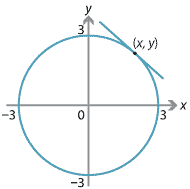Content
Implicit differentiation
Implicit differentiation is a powerful technique to find an instantaneous rate of change \(\dfrac{dy}{dx}\) when there is an equation relating \(x\) and \(y\). It applies even when \(y\) is not a function of \(x\). All that is required is that there is an equation relating \(x\) and \(y\).
For example, consider the curve in the plane described by the equation \(x^2 + y^2 = 9\). This is a circle centred at the origin, of radius 3.

Figure : The circle \(x^2 + y^2 = 9\).
Note that \(y\) is not a function of \(x\)! The circle fails the vertical-line test; we have a relation, not a function. (See the module Functions I for a discussion of functions and relations.) For a given value of \(x\), there may be two distinct values of \(y\):
\[ x^2 + y^2 = 9 \quad\iff\quad y = \pm \sqrt{9 - x^2}. \]Although \(y\) is not a function of \(x\), we can say that the equation \(x^2 + y^2 = 9\) expresses \(y\) as an implicit function of \(x\).
Suppose you want to find the gradient of the tangent to this circle at a point \((x,y)\). One approach would be to consider either \(f_1(x) = \sqrt{9-x^2}\) or \(f_2(x) = - \sqrt{9-x^2}\), depending on whether \(y\) is positive or negative, and then differentiate. (We saw the derivative of \(\sqrt{9-x^2}\) in exercise 17.)
The much better approach of implicit differentiation is to differentiate both sides of the equation \(x^2 + y^2 = 9\) with respect to \(x\). Differentiating \(y^2\) requires the chain rule, since \(y^2\) is a function of \(y\) and \(y\) is a function of \(x\):
\[ \dfrac{d}{dx}(y^2) = \dfrac{d}{dy}(y^2) \, \dfrac{dy}{dx} = 2y\,\dfrac{dy}{dx}. \]We can now differentiate each term of \(x^2 + y^2 = 9\), and we obtain
\[ 2x + 2y\,\dfrac{dy}{dx} = 0. \]Note the power of implicit differentiation: this equation involving \(\dfrac{dy}{dx}\) is valid for all points on the circle except \(y=0\). When \(y \neq 0\), we may solve for \(\dfrac{dy}{dx}\) and obtain
\[ \dfrac{dy}{dx} = - \dfrac{x}{y}. \]Without implicit differentiation, we would not have found such a neat formula!
From this formula, we can see that if \(x,y\) have the same sign, then the gradient of the tangent is negative; while if \(x,y\) are of opposite sign, then the gradient is positive.
Exercise 22
Give a geometric argument why the tangent at the point \((x,y)\) to a circle centred at the origin has gradient \(-\dfrac{x}{y}\).
Example
What is the gradient of the curve \(y^2 = x^3 - 7x\) at the points where \(x=4\)?
Solution
When \(x=4\), we have \(y^2 = 64 - 28 = 36\), so \(y = \pm 6\). Implicit differentiation of \(y^2 = x^3-7x\) gives
\[ 2y\,\dfrac{dy}{dx} = 3x^2 - 7. \]So when \(y \neq 0\), we obtain \(\dfrac{dy}{dx} = \dfrac{3x^2-7}{2y}\). Hence:
- At \((x,y) = (4,6)\), we have \(\dfrac{dy}{dx} = \dfrac{3 \cdot 4^2 - 7}{2 \cdot 6} = \dfrac{41}{12}\).
- At \((x,y) = (4, -6)\), we have \(\dfrac{dy}{dx} = \dfrac{3 \cdot 4^2 - 7}{2 \cdot (-6)} = - \dfrac{41}{12}\).
The curve in the previous example is called an elliptic curve.
